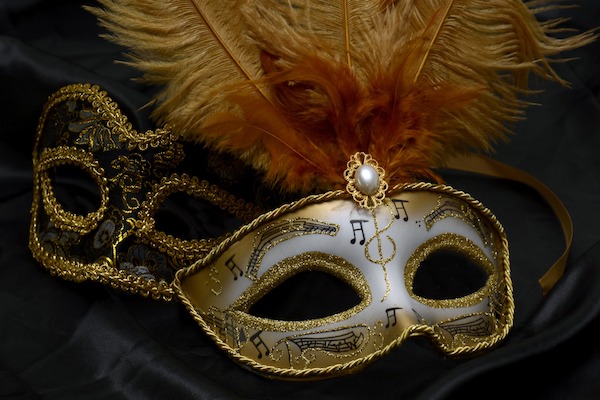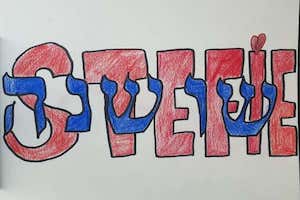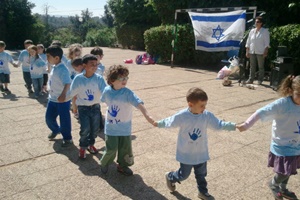Purim Costumes: We are what we wear
by Rabbi Binny Freedman

As we dress in costumes for the Purim celebration, it should be noted that one of the stories in the Megillah of Esther is very much about clothing.
Mordechai, a hero of the story, had recently saved the life of the Persian King Achashverosh from an assassination attempt, and it came to the King’s attention that Mordechai was never properly repaid for his service. The reward? Mordechai is led through the streets on a horse, dressed in “royal garb worn by the king,” while someone calls out before him: “So shall be done for the man whom the King desires to honor.” (Esther 6: 8-11)
The opening verses of the book of Esther point out that Achashverosh ruled a kingdom of 127 provinces; he had inherited the entire Babylonian empire, and yet the reward for saving his life was to be paraded on a horse wearing royal robes?
This story reminds us of another garment that played an important role in our history: the cloak of many colors given to Joseph by his adoring father Yaakov. There too, one wonders why Yaakov has chosen a piece of clothing as a symbol of his love for his son.
And when Mordechai, on hearing of Haman’s evil intention to destroy the Jews, wants to make a statement, he goes to the gates of the palace and puts on sackcloth. What is the message behind what we wear?
Imagine it is the evening of your son’s Bar Mitzvah, and you announce that you have a special gift for him on this special evening. Full of expectation, he comes forward to the front of the hall, and you unwrap for him … a colored bathrobe!
Or perhaps it is even a gift for your wife in appreciation of all that she does and all that she is to you, and you surprise her with … a mink coat! Where is the spiritual significance? Is this the message I want to give my children? That the item I view as the pinnacle of appreciation on this special evening is a piece of clothing?
According to Jewish tradition, one of the three things that allowed the Jewish people to survive the exile in Egypt for 200 years was that they kept their Jewish clothing. The externalities are really the first thing we see, and they are the first vehicles for any message we choose to communicate. Every morning we clothe ourselves in our Jewish clothing, our Tefillin and Tallit. The first symbol we wear as a sign of marriage are the wedding rings on our fingers.
But even deeper, clothing in this world is not only of cloth.
We also wear a different type of clothing; mystically, our actions are what really clothe us. The Sefer HaChinuch points out that the clothing was also a message to the Kohen that people are influenced by everything about him that they see.
Entire articles in business magazines are devoted to what a person should wear when going on important job interviews. Companies, understanding that the clothes of their employees influence the clients they come in contact with, devote an enormous amount of time to developing policies for just what their employees should and should not wear.
Perhaps the coat Yaakov gave Joseph was really a message that Joseph needed to hear. Joseph, according to the narrative in the Torah (Genesis 37:2) brought the tales of his brothers, especially the sons of the handmaidens, to Yaakov his father. He was a talebearer. So perhaps Yaakov was trying to teach Joseph that it takes many different colors to make a beautiful coat.
Perhaps the Jews of Shushan, who according to the book of Esther were more Persian than the Persians, needed to learn a similar lesson. They came to Achashverosh’s feast, wearing their Persian clothes and impressed by all the trappings of Persian royalty (Esther 1:4-7). And they later saw Mordechai wearing the Royal robes. Finally, Mordechai wears sackcloth, understanding that we are influenced by what we see, and not just by what we hear.
We all live to some degree, in America, and make no mistake about it, even in Jerusalem, America is everywhere.
America is the Persia of today, and she rules all the one hundred and twenty seven provinces with her influence. And we wear our American clothing so well, we are often more American than the Americans.
How many Jews today are readily recognizable as Jews? Have we disappeared in our costumes, into the landscape of western society?
Purim reminds us that our clothing is in the end a costume. An important one, with many messages, to be sure, but a costume nonetheless.
There is an amazing story of Rav Levi Yitzchak of Berditchev, which I actually read to our daughter in the hospital, in the Intensive Care Unit: “Everybody knows that the great and holy Rav Levi Yitzchak of Berditchev and Rav Baruch of Medzibozh were complete opposites.
Rav Baruch was very civilized. When he prayed, he hardly moved. When he sat with his family at the Shabbat table, he was so regal; he was king of the world.
But when Rav Levi Yitzchak prayed he jumped from one end of the room to the other. He would dance, turn around, and even fall to the ground. At his table, one had to be very careful. You never knew what to expect. In the middle of Kiddush, he might suddenly go absolutely wild; throw his cup in the air… You could end up with your Kiddush all over your lap.
Rav Levi Yitzchak wanted so much to spend a Shabbat with Rav Baruch, the Baal Shem’s grandson, that he finally invited himself. Rav Baruch said: “You can come, but you have to behave my way. Especially at the table, with my family, you must be very proper.” Rav Levi Yitzchak thought about it.
“The only way I can behave is if I don’t open my mouth. I won’t even pray, except to say ‘Amen.’ Because the minute I pray I’m not myself anymore, and the ecstasy carries me away…”
So he said to Rav Baruch: “When we’re making Kiddush, don’t ask me to say a blessing. Let me be absolutely silent, because it’s the only way I can control myself.”
The two Rebbes agreed, and Rav Levi Yitzchak came to Rav Baruch for Shabbat. All through the prayers he only answered ‘Amen.’ The prayer went beautifully. But everyone was sure that by Kiddush Rav Levi Yitzchak wouldn’t be able to hold it together, and he’d start jumping on the table. But Rav Baruch made Kiddush, and again, Rav Levi Yitzchak just answered ‘Amen.’
Now everybody knows that we always eat fish on Friday night. But some start with sour fish and some start with sweet fish. Rav Baruch was very civilized, so he had one of his Chassidim, acting as a waiter, bring around the fish and ask everyone if they would like some fish.
So the waiter came to Rav Levi Yitzchak and asked him, “Do you like sweet fish?” And that was all the poor Chassid had to ask. Rav Levi Yitzchak heard the question and began to yell: “Do I like fish? Do I love fish? I love Hashem! I love only G-d!” That was all it took for him to reach a state of spiritual ecstasy, and he jumped up on the table, grabbed the platter of fish and threw it up in the air. The fish hit the ceiling and began to drip on Reb Baruch’s Tallit (in those days the great Rebbes wore their tallit on Friday night at the table.) Everyone was aghast. Everyone except Rav Baruch, who for all his civilized behavior would never wash his Tallit after that feast, because, he said, the stains were holy. “These stains were made by a Jew who really loves G-d. How can I ever wash them out?”
After Rav Baruch’s death, the Tallit was passed down from one Rebbe to another to wear on Shabbat, but never washed. It became so precious that the Rebbes only wore it on Yom Kippur.
The holy Munkatcher Rebbe, the last to possess it, wore it only for Neilah, the final prayer of Yom Kippur. He must have foreseen the destruction that would be coming into the world with the Holocaust; his last will was to be buried in Rav Baruch’s Tallit, covered with the stains caused by one who loved only G-d.
There are many different types of holy clothing, but they are all ultimately meant to clothe what is really valuable: the person who lies beneath. And as with all things we come in contact with, they hide the deepest and highest meanings of the things that are truly valuable in this world. Beneath the clothing of sinew and bones, tissue and limbs that are our bodies, lies the soul, that indomitable fire of joy and light that is who we really are.
This Purim, may Hashem bless us all with a glimpse beneath the “cloak” that often hides us from each other, so that we can better appreciate the inner beauty of all those around us, and all people everywhere.

Rabbi Binny Freedman is a founder and Dean of Orayta, a leadership training program designed to equip post-high school boys with the requisite intellectual, textual and personal development skills necessary for becoming Jewishly engaged campus and community leaders. Rabbi Binny’s dedication to the development of this leadership cadre is predicated upon the vision that the quality of Jewish and Zionist education provided to our young adults directly shape their engagement with Israel and their Jewish heritage. He holds the rank of captain (res.) in the IDF, made Aliyah as a lone soldier and fought in the first Lebanon War. Binny is a survivor of the Sbarro’s pizzeria bombing in 2000, has appeared on CNN, MSNBC, and Fox news and has lectured in Universities and congregations around the world. He is married to Doreet and they are the proud parents of 4 children.








